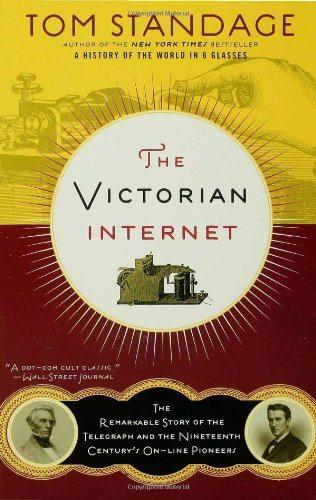The Victorian Internet by Tom Standage

Author:Tom Standage
Language: eng
Format: epub, mobi
Publisher: Bloomsbury Publishing Plc
Published: 2009-09-18T16:00:00+00:00
crYPTOGRAPHY—tinkering with codes and ciphers—was a common hobby among Victorian gentlemen. Wheatstone and his friend Charles Bab-bage, who is best known for his failed attempts to build a mechanical computer, were both keen crackers of codes and ciphers—Victorian hackers, in effect. "Deciphering is, in my opinion, one of the most fascinating of arts," Bab-bage wrote in his autobiography, "and I fear I have wasted upon it more time than it deserves."
He and Wheatstone enjoyed unscrambling messages that appeared in code in newspaper classified advertisements—a popular way for young lovers to communicate, since a newspaper could be brought into a house without arousing suspicion, unlike a letter or a telegram. On one occasion Wheatstone cracked the cipher, or letter substitution code, used by an Oxford student to communicate with his beloved in London. When the student inserted a message suggesting to the young woman that they run away together, Wheatstone inserted a message of his own, also in cipher, advising her against it. The young woman in serted a desperate, final message: "DEAR CHARLIE: WRITE NO MORE, OUR CIPHER IS DISCOVERED!" On another occasion Wheatstone cracked the code of a seven-page letter written two hundred years earlier by Charles I entirely in numbers. He also devised a cunning form of encryption, though it is generally known as Playfair's Cipher after his friend, Baron Lyon Playfair. Babbage too invented several ciphers of his own.
And there was certainly a demand for codes and ciphers; telegrams were generally, though unfairly, regarded as less secure than letters, since you never knew who might see them as they were transmitted, retransmitted, and retranscribed on their way from sender to receiver. In fact, most telegraph clerks were scrupulously honest, but there was widespread concern over privacy all the same.
"Means should be taken to obviate one great objection—at present felt with respect to sending private communications by telegraph—the violation of all secrecy," complained the Quarterly Review, a British magazine, in 1853. "For in any case half a dozen people must be cognizant of every word addressed by one person to another. The clerks of the [telegraph companies] are sworn to secrecy, but we often write things that it would be intolerable to see strangers read before our eyes. This is a grievous fault in the telegraph, and it must be remedied by some means or other." The obvious solution was to use a code.
Meanwhile, the rules determining when codes could and could not be used were becoming increasingly complicated as national networks, often with different sets of rules, were interconnected. Most European countries, for example, forbade the use of codes except by governments, and in Prussia there was even a rule that copies of all messages had to be kept by the telegraph company. There were also various rules about which languages telegrams could be sent in; any unapproved language was regarded as a code.
The confusion of different rules increased as more countries signed bilateral connection treaties. Finally, in 1864, the French government decided it was time to sort out the regulatory mess.
Download
This site does not store any files on its server. We only index and link to content provided by other sites. Please contact the content providers to delete copyright contents if any and email us, we'll remove relevant links or contents immediately.
Learning SQL by Alan Beaulieu(5418)
Weapons of Math Destruction by Cathy O'Neil(5043)
iGen by Jean M. Twenge(4703)
Digital Minimalism by Cal Newport;(4557)
Sapiens by Yuval Noah Harari(4545)
Elon Musk by Ashlee Vance(3457)
The Age of Surveillance Capitalism by Shoshana Zuboff(3429)
Thing Explainer by Randall Munroe(3333)
Apollo 8 by Jeffrey Kluger(3204)
Future Crimes by Marc Goodman(3005)
The Science Book (Big Ideas Simply Explained) by DK(2748)
Who Can You Trust? by Rachel Botsman(2733)
I Live in the Future & Here's How It Works by Nick Bilton(2529)
Infinite Energy Technologies by Finley Eversole(2494)
Dawn of the New Everything by Jaron Lanier(2441)
Steve Jobs by Walter Isaacson(2433)
Chernobyl by Serhii Plokhy(2129)
Energy Myths and Realities by Vaclav Smil(2064)
Ben Franklin's Almanac by Candace Fleming(2060)
